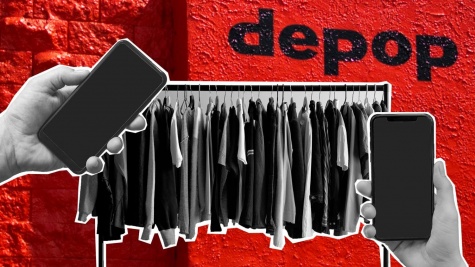
Eden Milligan | Head Editor
December 10, 2020
If you care about clothes, you’ve probably heard the buzz around Depop. The app allows its users from across the world to buy and sell items, everything from old wardrobe items to genuine vintage to handmade outfits. Though Depop is not the only app of this sort (Poshmark, thredUP, and Curtsy are also popular closet-swapping platforms), it seems to be the fan-favorite of our generation, and for good reason. The app is aesthetically formatted, conveniently organized, and inhabited by hundreds of great sellers and second-hand gems; what’s not to love?
“I think Depop is super helpful because you can either find a specific thing listed at different prices from multiple people, or thrifted and unique things you can’t find anywhere else,” junior Grace Verrilli said. “It’s very helpful for when you want something that you won’t see anyone else wearing.”
Depop has everything a fashionista could ever wish for: an innumerable quantity of unique items that give style limitless possibilities. But is the app losing its charm as more people discover it?
Depop has grown dramatically in popularity since the start of lockdown, as has the ensuing motivation to declutter and try (or buy) new things. Many people, myself included, tried to make the best out of their months at home by fine-tuning their personal style, organizing their closet, and making some extra cash. Depop is perfect for all of these things, so buyers and sellers poured in. This massive influx seemed great at first; it increased the diversity (more options!) and the numbers of items listed which, in theory, would make prices go down.
However, in this period when people flooded into Depop, a shift that could be likened to the gentrification of a poor neighborhood occurred as wealthy people, who had probably not considered second-hand shopping before, appeared on the app. Though some prices on Depop were always high, as it is entirely up to the seller to set their pricing for each item—which means that some things are inevitably overpriced—and a shift started occurring as prices would rise and rise, and yet items would continue to sell.
For whatever reason, the teens and young adults of Depop deemed certain items highly valuable and worth much more than their retail price. The influx in value of certain items is largely influenced by TikTok, as many people were inspired by TikTokers who showcased their unique styles. Subsequentially, this makes people want to hunt for specific pieces and brands to imitate their idols.
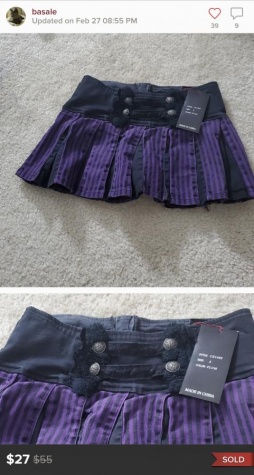
This resulted in a major spike in the popularity of certain vintage brands, like Tripp NYC, which was created in 1980 and became very popular at Hot Topic in the 90s and early 2000s. Tripp helped create the foundation of the “mall goth” subculture, which is now coming back into style due to, you guessed it, TikTok. Ironically, the term “mall goth” was originally intended as an insult by real goths, who believed that people who got their clothes from the shopping mall at stores like Hot Topic were posers. Now, Tripp and other similar “mall goth” brands are yet again causing division: this time, between those who followed the brands before they were popular on TikTok and those who recently discovered the new “mall goth” trend.
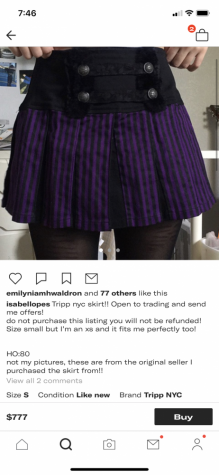
Unfortunately, the recent influx of trend-following teens who are willing to pay a great deal of money for certain items is pushing the original group of adamant alternatives out of the scene. “One of my favorite bands of all time is Tripp NYC, and I have been a fan of them since before quarantine,” junior Magdalena Alexandar said. “Before everyone decided to change their style all of a sudden, I could find a skirt for $20 or $30. Now you cannot find a cute Tripp NYC skirt for anything less than like 200 bucks.”
To achieve an “alternative” style for a reasonable price, people must pull away from Depop.
“The price spike… is making it almost impossible for people to have the style I have without supporting fast fashion directly or shopping unethically,” Alexander said. “It’s definitely not okay that an app that was literally made to buy and sell affordable vintage and secondhand pieces like an online thrift store has become this overpriced.”
This shift in prices has more effects than merely depriving some people of 90s alternative clothes. As Depop sellers are marketing items to the rich, probably recently-alternative buyers, who then resell these items, they lose their meaning and original tie to alternative subcultures.
“It’s sad that people are capitalizing on the destruction of subcultures,” Alexander said. “The whole point of every alternative subculture is that it is not excluded to one class, so this infiltration of high prices on things that are labeled as alternative is really just taking a step backward for alternative culture in general.”
To Alexander’s point, the entire basis of most alternative subcultures (which pretty much were all derived from 80s punk) was a rebellion against the established elite. Now, the “elite” may be changing the meaning of alternative through Depop, or at least creating a new definition.
This “gentrification” of Depop is not only affecting alternative style, however.
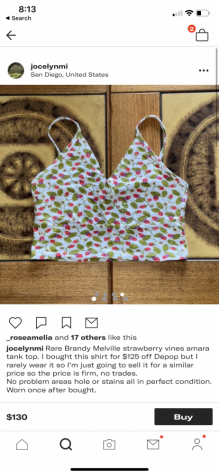
This tank top once sold at the popular store Brandy Melville for around $20.
Even popular brands like Brandy Melville have been subject to catastrophic price hikes when an item is deemed “rare” and “in high-demand.” A tank top that once wet for under $25 may sell for $130, which, of course, would only make this tank top accessible to the very privileged.
If you’re looking to sell on Depop, and you’re lucky enough to own a “rare” item, you might just be in luck! However, if you are looking to achieve a trendy style at an affordable price, you’d probably be better off spending a whole day scavenging through thrift sores than turning to Depop (at least for now).
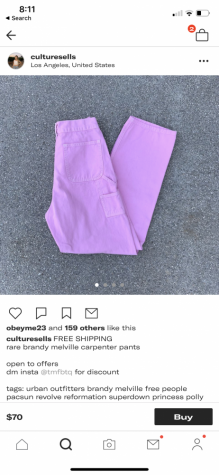
Though Depop remains an incredible shopping tool for the diversity of things that can be found on the app, it seems it may be best to stay away from current “trendy” styles, as prices are often hiked up far higher than the actual value of the item. Just because something is “rare” or “deadstock” does not mean it is worth half your savings account. However, in some select cases, like with genuine unique vintage pieces, high prices may be reasonable.
“I understand higher prices for real vintage, expensive material, or hand-made items but seeing a 2014 Brandy Melville shirt listed for an absurd price is straight-up aggravating,” Verrilli said.
It seems the days of good deals on Depop are over, as the app has become overrun by those willing to overpay. However, even as many specific clothing pieces and brands become outrageously expensive, there are always good deals to be found if you search hard enough.

Great article! You covered so many issues here. My freshman is really into Depop. I’m going to send this to her.
Another example of influencers ruining a good thing. Honestly, I can’t think of much value that they truly provide that would warrant the amount of money some of them make.
That being said, vintage and thrift stores are still an option, and have always been a good way to repurpose clothing.
Thanks for your comment, Mr. Kerr!
Unfortunately, it is now much harder to find clothes at thrift and vintage stores, because there are hundreds of Depop sellers who have made a career out of buying up clothes every morning to sell for a much higher price on Depop. I’ve seen them: they shop with a purpose and leave nothing behind. It’s much harder to come across a great thrift find nowadays, which is really unfortunate especially for the people who rely on thrift stores and are not able to afford Depop prices. Hopefully the influencers will move on to something else and leave second-hand shopping alone!